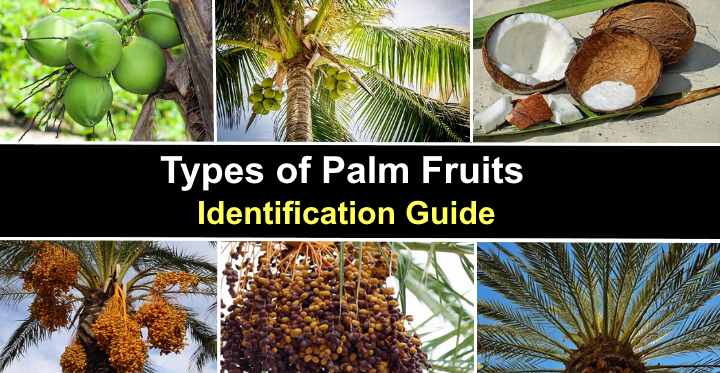Palm trees bear a wide range of edible fruits in different shapes and colors, including the famous dates and coconuts. Other varieties of palm fruits include round black berries, brown oval drupes, and clusters of sticky fruits in dark red to orange shades. In this article, we will provide a detailed description of 12 different types of edible palm fruits. While some of these fruits can be found in local stores, others are processed by the food industry or used as health supplements.
What Fruit Grows on Palm Trees?
Palm trees are a type of perennial flowering plant that has approximately 2,600 species belonging to the family Asclepiadaceae. Despite being referred to as trees, palms are actually herbaceous and woody plants. Palms are quite diverse and can produce a wide variety of fruits with unique flavors. In addition to the popular coconut and date palms, there are other types of fruit-producing palms, such as the acai berry, saw palmetto, jelly palm, and betel nut palm, among others.
The fruits of palm trees come in different shapes, colors, and sizes. For instance, date palm fruits are brown, red, or black drupes with a sweet, sticky flesh that surrounds a hard stone. Meanwhile, the coconut palm fruit is unique, with the edible portion contained within its seed. Additionally, the fibrous covering around the coconut seed, known as coir, is used as an alternative to peat moss.
Although the oil palm fruit is generally not consumed directly, its pulp and seeds are used to extract vegetable oil for use in the food and cosmetics industries. Palms have evergreen fronds that grow from a single unbranched stem, giving them their distinct tropical appearance.
Types of Palm Fruits (with Pictures) – Identification Guide
Let’s look in more detail at how to identify common types of palm fruit.
Coconut Palm Fruit (Cocos nucifera)

The coconut palm produces a large, round or oval-shaped fruit that can grow up to 8 inches (20 cm) in diameter and 18 inches (45 cm) long when it is immature. The mature coconut seed, which is recognizable by its brown color and hairy fiber, is protected by a thick husk. The weight of a coconut is about 3 pounds (1.4 kg).
Although it is commonly referred to as a nut, the fruit of the coconut palm is actually a drupe, which means it has a central stone or seed surrounded by a thick flesh or mesocarp. Mature coconuts, which are often sold as large, oval-shaped, hard brown fruits, are the easiest to identify.
Inside the coconut, there is a thick white meat and a clear liquid known as coconut water. By piercing the soft part of a mature coconut, the nutritious coconut water can be obtained. Coconut oil is made from the sliced, grated, or roasted meaty substance and is used in cooking.
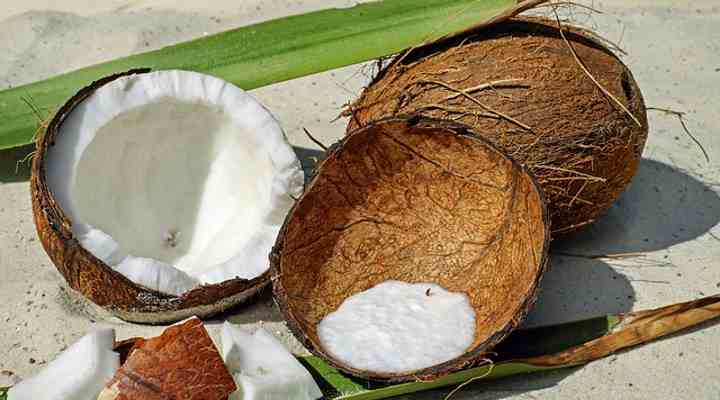
Coconuts are roundish fruits that grow on coconut palm trees at heights of several meters. A young coconut is characterized by a greenish or yellowish color and a hard, brown, hairy, fibrous shell. The spherical fruit contains coconut water, a liquid, and coconut meat, a jelly-like substance. To consume the coconut water, a green coconut is typically sliced open, and the liquid is drunk straight from the fruit.

In tropical regions, it’s common to see people drinking fresh coconut water from freshly harvested coconut palm fruit. The Pacific variety of coconuts that are domesticated have a round shape when they grow on the palm tree. On the other hand, wild coconuts have a long, triangular shape.
Date Palm Fruit (Phoenix dactylifera)

The date palm tree produces a large, soft, oval-shaped drupe that comes in a variety of colors, including bright red, yellow, and dark brown. The fruit grows in large clusters and is typically fibrous in texture.
The dates themselves are oval-cylindrical in shape and range from 1″ to 3″ (2.5 – 7 cm) in length. The date palm tree is easily recognizable on tall palm trees with large, distinctive clusters of fruit that can grow up to 4 feet (1.2 meters) long.
Depending on the climate and age of the tree, date palm trees can produce up to 200 pounds (90 kg) of fruit each year. Medjool dates are the most popular type of sweet date, known for their slightly wrinkled skin, sticky flesh, and soft texture. They are commonly used in desserts or savory dishes, either alone or chopped.

Medjool dates are not the only type of date available. Deglet Nour dates, for example, have a honey-like flavor and are dark brown in color. Sukkari dates have a golden yellow, soft and juicy flesh that is mouthwatering. Ajwa dates, on the other hand, have rough black skin, velvety flesh, and a rich, delicious flavor. There are several other varieties of dates available as well, each with their own unique taste and texture.
Açaí Palm Fruit (Euterpe oleracea)
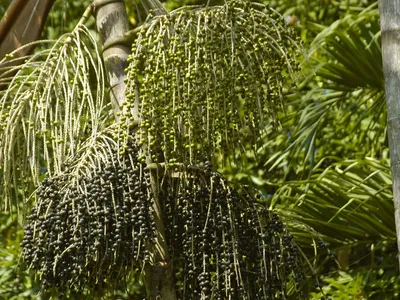
Acai palm fruits are spherical in shape and resemble grapes, with a black appearance when ripe. These fruits grow in clusters of 500 to 900 berries on drooping branches. The pulp surrounding the single seed is edible, and the berries are approximately 1 inch (2.5 cm) in diameter.
You can recognize a ripe acai palm fruit when its spherical berries turn dark purple, almost black in color. The edible portion of the fruit is small compared to the large seed. Acai berries have an earthy flavor that is similar to blackberries and unsweetened chocolate.
Fresh acai berries are challenging to find outside of South America due to their short shelf life. However, acai berry supplements are marketed for their antioxidant properties and potential health benefits. Acai palm fruit oil is also used in cosmetics.
Pindo Palm Fruit – Jelly Palm Fruit (Butia capitata)
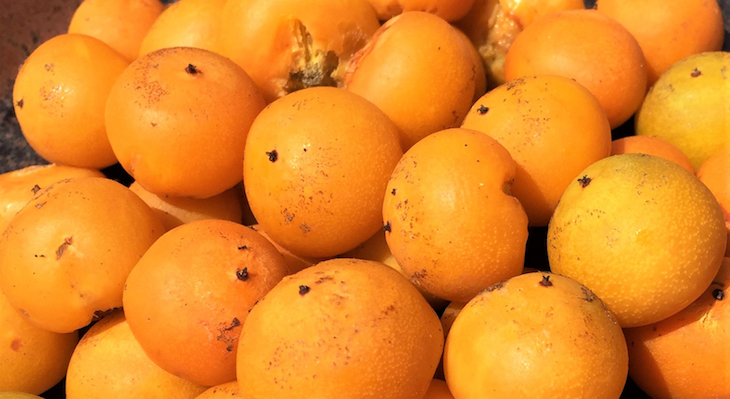
The Pindo palm fruit, also called the jelly palm fruit, has a cherry-like appearance and comes in an orange-yellow color. The fruit is approximately 1″ (2.5 cm) in diameter and grows in large clusters like other palm tree fruits. The jelly palm fruit gets its name from the high levels of pectin present in the spherical orange drupes.
When consumed raw, the jelly palm fruit has a taste resembling apricots, pineapple, or banana. These round, ripe jelly palm berries are commonly used to create a sweet and tart jelly. Many homeowners in southern states, such as Florida, cultivate Pindo palm trees for their attractive appearance in landscaping. However, the abundance of palm fruit can make the tree quite messy.
When ripe, the yellow or orange palm fruit drops to the ground, and there are usually more palm berries than a family can consume.
Saw Palmetto Palm Fruit (Serenoa repens)
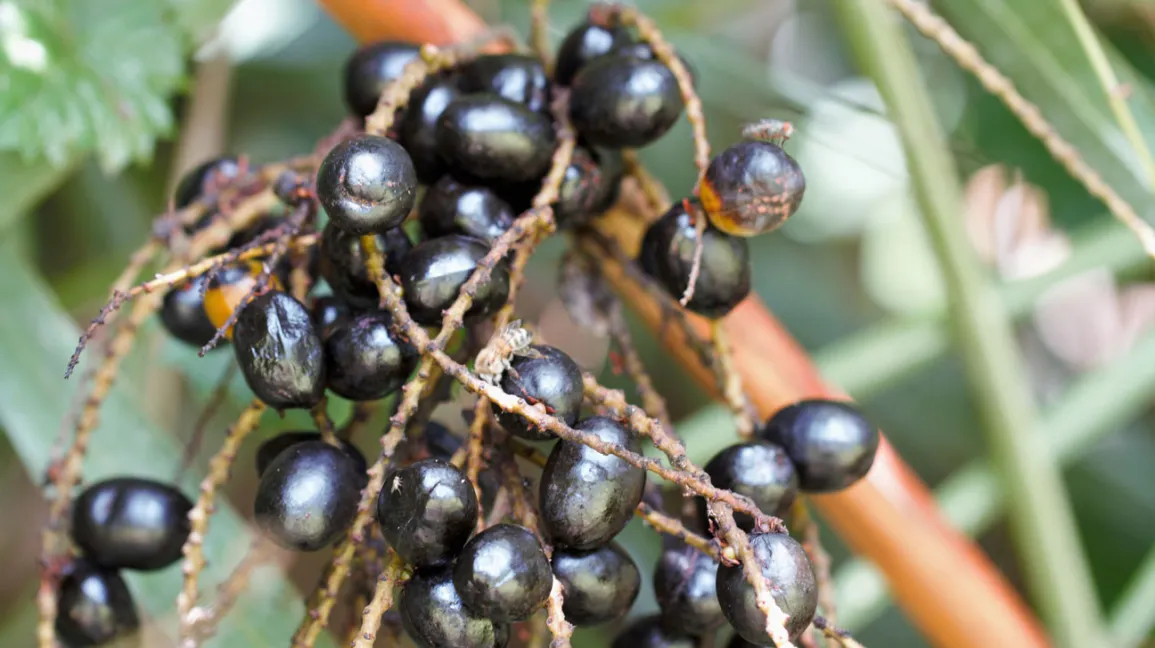
Saw palmetto palms are native to Florida and produce small, black, olive-shaped drupes. The fruits grow in clusters and are approximately 0.5″ to 1″ (1.3 – 2.5 cm) in length. Saw palmetto fruits have a strong aroma and a blue cheese-like flavor, but they are not widely used in cooking due to their pungent taste. However, the dried berries are commonly used for their health benefits, especially for men’s health, and are sold in powdered form as supplements.
Peach Palm Fruit (Bactris gasipaes)

The peach palm fruit is easily distinguishable based on its color, which varies from red, yellow to orange, depending on the species of the palm tree. The fleshy fruit grows in hanging clusters that are approximately 2.4 inches (6 cm) long and 2 inches (5 cm) wide.
The palm fruit is easily visible on the palm tree, and each cluster can contain up to 300 fruits. The tree can have up to five clusters of oval-shaped orange or red fruits, depending on its age, and the clusters can weigh up to 26 pounds (12 kg) each.
Oil Palm Fruit (Elaeis guineensis)
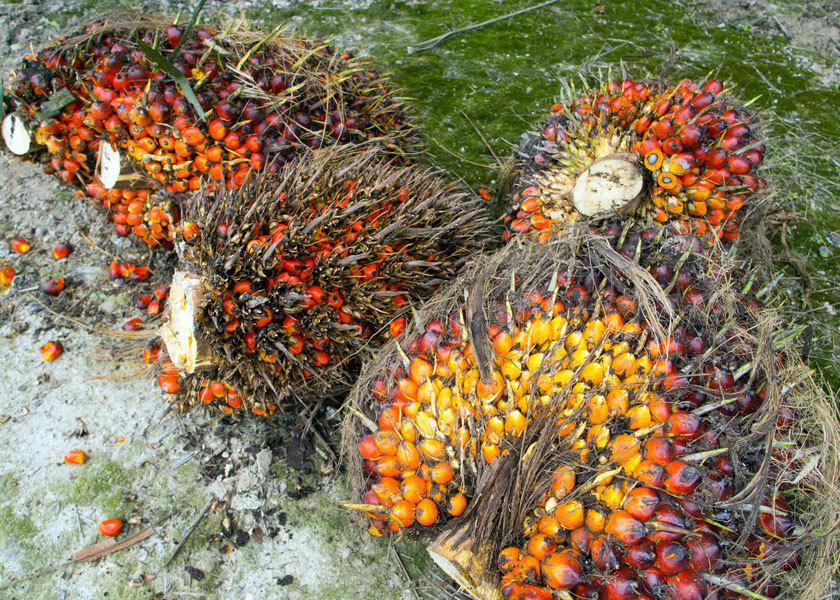
The oil palm fruit is a large, round fruit that ranges in color from orange to dark red and is commonly used for oil production. These spherical fruits grow in clusters, similar to other types of palm fruit. The oily flesh and oil-rich kernel of each red palm fruit are extracted to produce vegetable oil.
Depending on the size of the cluster, oil palm fruits can weigh between 11 and 66 pounds (5 and 30 kg) each. The extraction process involves pressure squeezing the oil from the pulp and kernel, yielding up to 48 lbs. (22 kg) of vegetable palm oil and 3.5 lbs. (1.6 kg) of palm kernel oil per 220 lbs. (100 kg) of fruit used.
Betel Nut Palm Fruit (Areca catechu)
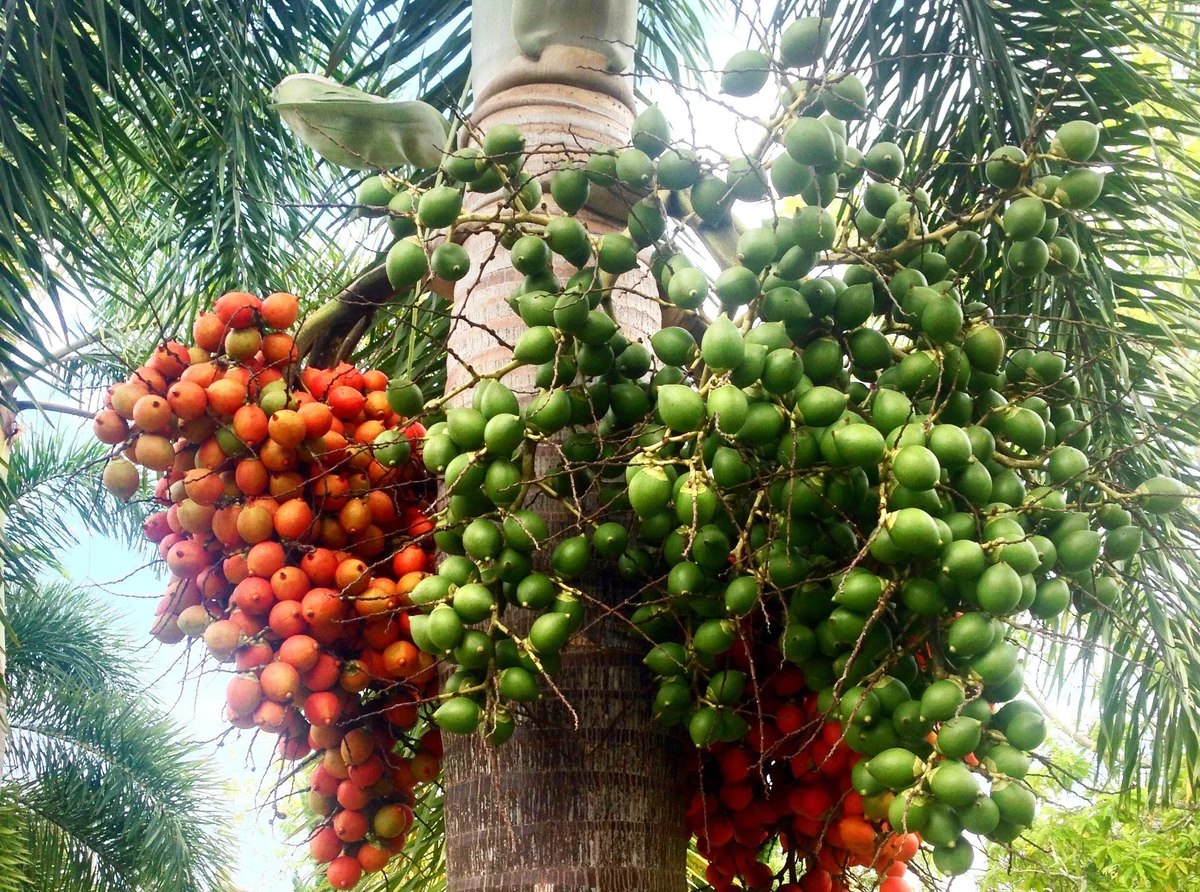
The areca nut is a small brown palm fruit that grows up to 2 inches (5 centimeters) long on the immature betel nut palm tree. Despite its name, it is a hard-shelled drupe, and its outer layer becomes a hard, fibrous shell when ripe.
In Southeast Asia, the fruit is chewed along with the betel leaf for its stimulant properties, and it is known as the betel nut. However, chewing betel nut has been linked to various adverse effects and health problems.
Snake Palm Fruit (Salacca zalacca)
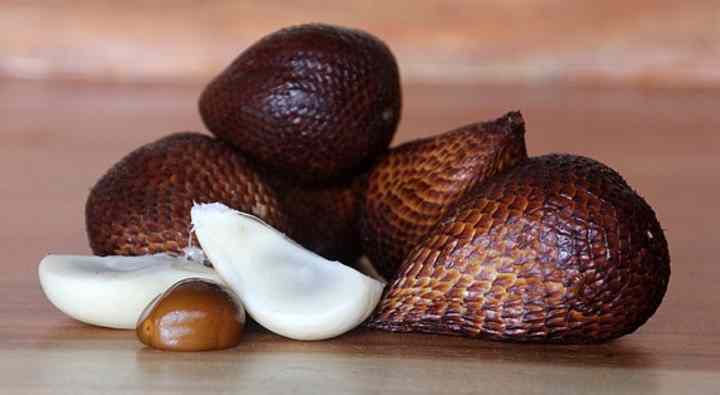
The snake fruit, also called salak fruit, is an egg-shaped palm fruit with a scaly brown skin that resembles a snake. The fruit has a sweet and tangy white pulp that is edible and is segmented into three lobes. The lobes are similar to garlic bulbs, and each contains an inedible seed.
The brown and scaly skin of the fruit covers the white pulp, giving it its name. When eaten, the firm pulp produces an apple-like sensation, but with a sweet to astringent flavor. The fruit is grown in Java and Sumatra, Indonesia, and is also referred to as the snakeskin palm or salak tree fruit.
Chilean Wine Palm Fruit (Jubaea chilensis)

Coquito is the name given to the small, spherical fruit of the wine palm tree found in Chile. These palm fruits are yellow or brown in color, and are typically 0.8 to 1.2 inches (2 to 3 cm) in diameter. The outer shell of the fruit is hard and the flesh inside is creamy white.
Although edible, coquito fruits have a soapy and unpalatable taste. Chilean wine palms derive their name from the sap that is extracted from them, which is used to make palm wine or palm syrup. However, cutting down these palm trees is prohibited due to their endangered status.
Guadalupe Fan Palm Fruit (Brahea edulis)
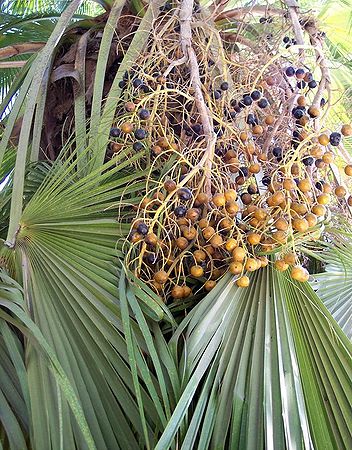
Guadalupe fan palm fruit is a small round fruit that is golden yellow in color and measures about 1-1.5 inches (2.5-3.8 cm) in diameter. The fruit has a sweet taste similar to dates and is a true drupe, which means that it has a hard seed at the center and a sticky pulp surrounding it. Guadalupe fan palm fruit can be eaten raw or used to make a sweet preserve.
California Fan Palm (Washingtonia filifera)

The California fan palm tree produces small, round fruit that grows in clusters. These drupes are tiny, measuring only 0.23 to 0.4 inches (0.6 to 1 cm) in diameter and can come in black, brown, or yellow. Despite the relatively small amount of edible flesh compared to the hard seed at the center, the sweet and delicious pulp of the California palm fruit is highly regarded. Another name for the California fan palm is the desert fan palm or Washingtonia filifera.
